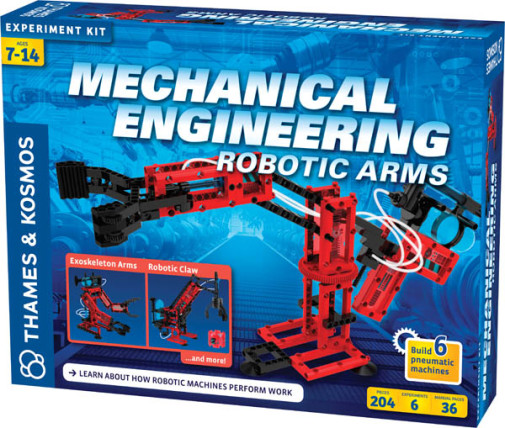We use cookies to make your experience better. To comply with the new e-Privacy directive, we need to ask for your consent to set the cookies. Learn more.
Mechanical Engineering: Robotic Arms
Robotic arms are a remarkable scientific innovation that function and appear similar to a human arm. Often, they are able to perform tasks with greater strength, accuracy or speed than their human equivalent--and tasks deemed unsafe for humans. Weaving together mechanical engineering, electrical structures and computer systems, robotics is a field that excites children. Take advantage of their natural curiosity! Using a pneumatic system to activate the models, children construct a pivoting robotic arm, a robotic hand, grabber, claw and exoskeleton legs and arms. Full color instruction manual provides 6 experiments in 3 difficulty levels, step by step illustrated instructions and 204 pieces to set your child free to test their mechanical engineering skills. You supply scissors, ruler or measuring tape. ~ Deanne
Build six mechanical models of the types of arms, grabber claws, and legs found on robotic machines. Explore mechanical engineering principles firsthand as you assemble and play with these working models.
The models use a pneumatic system which uses air pressure to activate the models. Pump up the air reservoir with the hand pump, then flick the switch to operate the model: A pneumatic piston enables the grabber claws to open and close rapidly and to grip objects with enough force to lift them. The piston can also move the arms and legs on models back and forth, demonstrating how robotic limbs move.
Construct a pivoting robotic laboratory arm with gripper claw. Assemble an extra long grabber claw to pick up things that are just out of reach. Build a vertical three-fingered claw that can lift a cup up off the table keeping it level. Experiment with models of robotic exoskeleton arms and legs. Make a compact grabber claw that you can slip into your shirt sleeve to pretend you have a robotic hand.
Learn how pneumatic and hydraulic systems are used in industrial robots to enable the robots to manipulate heavy objects, such as automobile components.
A 32-page, full-color manual guides you through model building with step-by-step illustrated instructions.
| Product Format: | Other |
|---|---|
| Brand: | Thames and Kosmos |
| Grades: | 2-AD |
| EAN/UPC: | 814743012592 |
| Length in Inches: | 11.25 |
| Width in Inches: | 14.5 |
| Height in Inches: | 3.625 |
| Weight in Pounds: | 2.6 |

